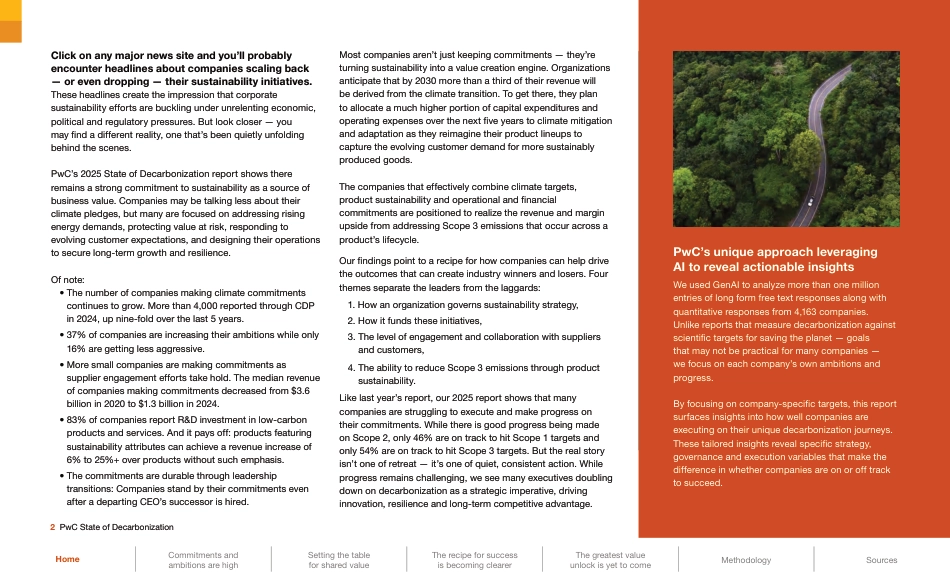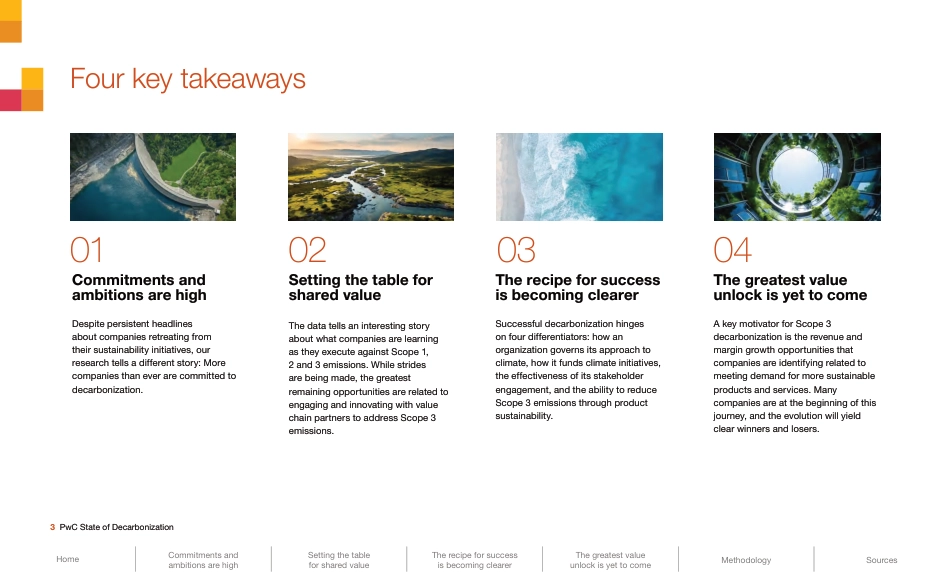1PwCDecarbonizationsolutionsPwC’sSecondAnnualStateofDecarbonizationReportEssentialingredientsforachievingyourclimateambitionClickonanymajornewssiteandyou’llprobablyencounterheadlinesaboutcompaniesscalingback—orevendropping—theirsustainabilityinitiatives.Theseheadlinescreatetheimpressionthatcorporatesustainabilityeffortsarebucklingunderunrelentingeconomic,politicalandregulatorypressures.Butlookcloser—youmayfindadifferentreality,onethat’sbeenquietlyunfoldingbehindthescenes.PwC’s2025StateofDecarbonizationreportshowsthereremainsastrongcommitmenttosustainabilityasasourceofbusinessvalue.Companiesmaybetalkinglessabouttheirclimatepledges,butmanyarefocusedonaddressingrisingenergydemands,protectingvalueatrisk,respondingtoevolvingcustomerexpectations,anddesigningtheiroperationstosecurelong-termgrowthandresilience.Ofnote:•Thenumberofcompaniesmakingclimatecommitmentscontinuestogrow.Morethan4,000reportedthroughCDPin2024,upnine-foldoverthelast5years.•37%ofcompaniesareincreasingtheirambitionswhileonly16%aregettinglessaggressive.•Moresmallcompaniesaremakingcommitmentsassupplierengagementeffortstakehold.Themedianrevenueofcompaniesmakingcommitmentsdecreasedfrom$3.6billionin2020to$1.3billionin2024.•83%ofcompaniesreportR&Dinvestmentinlow-carbonproductsandservices.Anditpaysoff:productsfeaturingsustainabilityattributescanachievearevenueincreaseof6%to25%+overproductswithoutsuchemphasis.•Thecommitmentsaredurablethroughleadershiptransitions:CompaniesstandbytheircommitmentsevenafteradepartingCEO’ssuccessorishired.Mostcompaniesaren’tjustkeepingcommitments—they’returningsustainabilityintoavaluecreationengine.Organizationsanticipatethatby2030morethanathirdoftheirrevenuewillbederivedfromtheclimatetransition.Togetthere,theyplantoallocateamuchhigherportionofcapitalexpendituresandoperatingexpensesoverthenextfiveyearstoclimatemitigationandadaptationastheyreimaginetheirproductlineupstocapturetheevolvingcustomerdemandformoresustainablyproducedgoods.Thecompaniesthateffectivelycombineclimatetargets,productsustainabilityandoperationalandfinancialcommitmentsarepositionedtorealizetherevenueandmarginupsidefromaddressingScope3emissionsthatoccuracrossaproduct’slifecycle.Ourfindingspointtoarecipeforhowcompaniescanhelpdrivetheoutcomesthatcancreateindustrywinnersandlosers.Fourthemesseparatetheleadersfromthelaggards:1.Howanorganizationgovernssustainabilitystrategy,2.Howitfundstheseinitiatives,3.Thelevelofengagementandcollaborationwithsuppliersandcustomers,4.TheabilitytoreduceScope3emissionsthroughproductsustainability.Likelastyear’sreport,our2025reportshowsthatmanycompaniesarestrugglingtoexecuteandmakeprogressontheircommitments.WhilethereisgoodprogressbeingmadeonScope2,only46%areontracktohitScope1targetsandonly54%areontracktohitScope3targets.Buttherealstoryisn’toneofretreat—it’soneofquiet,consistentaction.Whileprogressremainschallenging,weseemanyexecutivesdoublingdownondecarbonizationasastrategicimperative,drivinginnovation,resilienceandlong-termcompetitiveadvantage.PwC’suniqueapproachleveragingAItorevealactionableinsightsWeusedGenAItoanalyzemorethanonemillionentriesoflongformfreetextresponsesalongwithquantitativeresponsesfrom4,163companies.Unlikereportsthatmeasuredecarbonizationagainstscientifictargetsforsavingtheplanet—goalsthatmaynotbepracticalformanycompanies—wefocusoneachcompany’sownambit...



 VIP
VIP VIP
VIP VIP
VIP VIP
VIP VIP
VIP VIP
VIP VIP
VIP VIP
VIP VIP
VIP VIP
VIP